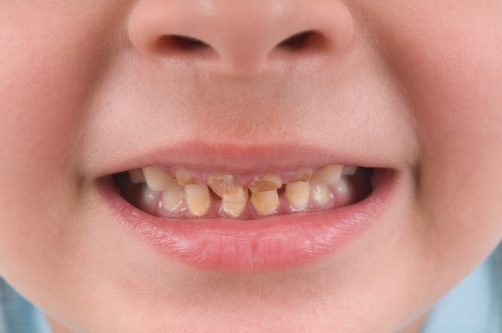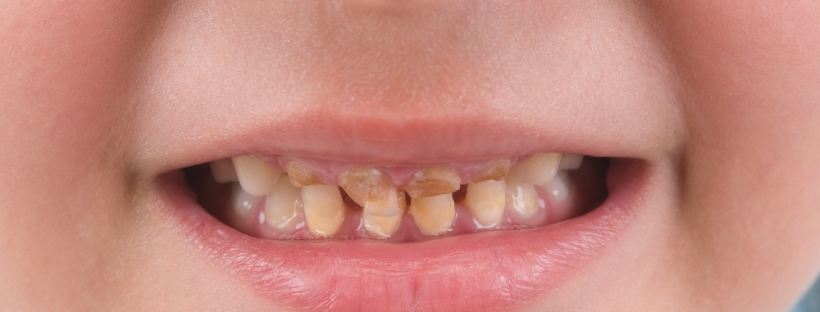What Is Tooth Decay?
Tooth decay means the destruction of our tooth enamel, which is the hard outer layer of our teeth. Tooth decay is also known as dental caries or cavities. ‘Caries’ is a Latin word which means ‘rottenness.’ Tooth decay can happen to anyone. A sticky film of bacteria called ‘Plaque’ continuously forms on our teeth.
Whenever we eat and drink food that contains sugar, the bacteria present in the plaque form acids, which attack our tooth enamel. Plaque, the sticky film layer keeps such acids in contact with our teeth. Due to the continuous exposure to such acids, the enamel of our teeth breaks down over time which causes cavities.

Tooth Decay
Cavities are mainly seen among children, but due to various factors, it can be a problem for adults too. Increased rate of gum disease combined with receding gums away from our tooth exposes our tooth roots to plaque. A soft tissue called cementum that covers our tooth roots are susceptible to decay. These tissues are sensitive to touch and temperature. Such conditions are mainly seen in the people over the age of 30.
Causes
Tooth decay is mainly caused by dental plaque that lies on the surface of our teeth. Dental plaque is also called biofilm. Some sites of our teeth that do not get enough saliva are prone to dental plaque.
In the presence of certain fermentable sugars such as sucrose, fructose, and glucose, bacteria present in the dental plaque produce acids. Due to the production of such acids, the inorganic minerals present on the outermost part of our teeth get dissolved, which ultimately causes tooth decay.
Studies say, around 32% of the world population is suffering from the problem of tooth decay. According to WHO, approximately all adults have the problem of tooth decay at some point in their life.
Symptoms
Symptoms of tooth decay include:
- Presence or appearance of a chalky white spot on the surface of our tooth which indicates demineralization of the enamel layer; This is known as ‘microcavity.’
- A severe form of microcavity is called ‘Cavities’ where the enamel and dentin layer are damaged severely. In such condition, we can easily see the visible damaged part.
- A persistent toothache and weakened tooth caused by the extensive internal decay.
- Bad breath.
- Foul taste.
At the early stages of the disease, a person may not be able to experience any symptoms, but as the cavity takes its severe form, it turns out to be a complicated problem; This can also bring threat to our lives sometimes.
Prevention
- Brushing our teeth twice, daily. This preventive measure shouldn’t be overlooked. Brushing our teeth twice a day destroys the bacteria and plaque build-up on the surface of our teeth.
- Along with brushing, we should also floss daily. Flossing cleans the crevices of our teeth.
- We should avoid sugary and starchy foods as much as possible. These sugars help bacteria in the biofilm to produce acids that erode the enamel layer.
- We should always use an antibacterial mouthwash.
- We should use fluoride toothpaste to strengthen our tooth enamel.
- Using a tongue scraper or a toothbrush we should brush our tongue daily. Our language harbors a lot of bacteria that can be harmful to our teeth.
- We shouldn’t ignore the problems like inflamed gums, pain in teeth and gum bleeding. We should immediately consult a doctor if such types of symptoms show up.
- We should regularly visit our dentist for a cleaning and dental check-up twice a year. A regular visit to our dentist ensures the safety of our teeth.
Cure
Treatment of tooth decay depends on the severity of the condition. Following are some of the procedures:
- At the very early stages of tooth decay, fluoride treatment can be taken which restores the enamel and reverses the cavity.
- Fillings made of porcelain or dental amalgam is done in the case of extreme dental decay.
- In the severe case of tooth decay, a crown made of porcelain, resin or porcelain fused materials is used to replace the natural crown of our teeth.
- In extreme cases, teeth extraction has to be done. Dental implants are installed to fill the gap created due to extraction.
Related Article: EIGHT EASY STEPS TO HELP YOU MAINTAIN GOOD ORAL HYGIENE
Tooth decay can occur to anyone. One should take the necessary precautions at the earliest to prevent it. Dr. Ross Quartano, a Covington Dentist, highly recommends that one should maintain healthy oral hygiene to get rid of the problem.
